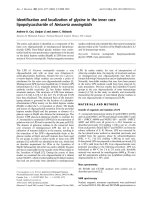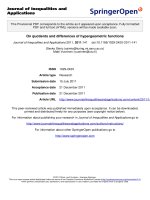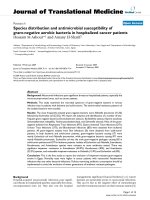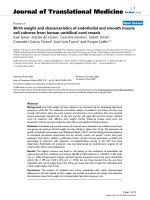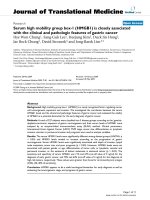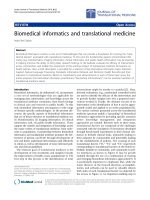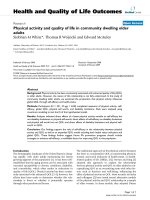báo cáo hóa học: " Work-related stress and bullying: gender differences and forensic medicine issues in the diagnostic procedure" pdf
Bạn đang xem bản rút gọn của tài liệu. Xem và tải ngay bản đầy đủ của tài liệu tại đây (331.25 KB, 6 trang )
RESEARC H Open Access
Work-related stress and bullying: gender
differences and forensic medicine issues in the
diagnostic procedure
Stefano Tonini
1,2*
, Andrea Lanfranco
1,2
, Antonio Dellabianca
1
, Diego Lumelli
1,2
, Ines Giorgi
3
, Fulvio Mazzacane
4
,
Camilla Fusi
5
, Fabrizio Scafa
1,2
and Stefano M Candura
1,2
Abstract
Background: The attention of international agencies and scientific community on bullying and work-related stress
is increasing. This study describes the gender differences found in victims of bullying and work-related stress in an
Italian case series and analyzes the critical issues in the diagnostic workup.
Methods: Between 2001 and 2009 we examined 345 outpatients (148 males, 197 females; mean age: 41 ± 10.49)
for suspected psychopathological work-related problems. Diagnosis of bullying was established using international
criteria (ICD-10 and DSM-IV).
Results: After interdisciplinary diagnostic evaluation (Occupational Medicine Unit, Psychology and Psychiatry
Service), the diagnosis of bullying was formulated in 35 subjects, 12 males and 23 females (2 cases of Post-
Traumatic Stress Disorder and 33 of Adjustment Disorder). Fifty-four (20 males, 34 females) suffered from work-
related anxiety, while work-unrelated Adjustment Disorder and other psychiatric disorders were diagnosed in 7 and
112 subjects, respectively. Women between 34 and 45 years showed a high prevalence (65%) of “mobbing
syndrome” or other work-related stress disorders.
Conclusions: At work, women are more subject to harassment (for personal aspects related to emotional and
relational factors) than men. The knowledge of the phenomenon is an essential requisite to contrast bullying;
prevention can be carried out only through effective information and training of workers and employers, who have
the legal obligation to preserve the integrity of the mental and physical status of their employees during work.
Keywords: psychosocial risk, mobbing, women’s work, risk evaluation
Background
Few studies about gender differences in bullying have
been carried out, despite the increasing attention of
Institutions and the international scientif ic community.
This study describes gender differences in the victims of
bullying and work-related stress examined in the Occu-
pational Medicine Unit of our Institute, and analyzes,
from a forensic point of view, the critical issues still pre-
sent in the diagnostic workup.
So far, the “mobbing syndrome” does not have a clear
nosological definition. The ICD-10 (International
Classification of Disease) and DSM-IV (Diagnostical and
Statistical Manual of Mental Disorders) indicate two
conditions, not necessarily work-related, that are directly
related to stress: 1) the Post-Traumatic Stress Disorder
(PTSD), characterized by behaviors aimed at avoiding
any situation that reminds a certain problem, obsessive
thinking about work issues, alertness and anxiety; and 2)
the Adjustment Disorder (AD), with risk factors and
clinical features similar to PTSD, but of less intensity
and severity. These are also the only recognized nosolo-
gical entities by the Italian workers compensation
system.
Recently, attention to gender differences in employ-
ment is gradually increasing from a sectorial knowledge,
* Correspondence:
1
Department of Public Health and Neuroscience, University of Pavia, Pavia,
Italy
Full list of author information is available at the end of the article
Tonini et al . Journal of Occupational Medicine and Toxicology 2011, 6:29
/>© 2011 Tonini et al; licensee BioMed Central Ltd. This is an Open Access article distributed under the terms of the Creative Commons
Attribution Lice nse ( which permits unrestricted use, distribution, and reproduction in
any medium, provided the original work is properly cite d.
concerning few interested researchers, to a widespread
information [1,2].
Stress is perceived by workers as the second most
important health threat and affects approximately 22% of
the workforce. Also, stress-induced damage is relevant
not only to individuals, but also to companies: a propor-
tion of 50 to 60% of all working days is lost because of
stress [3]. In 2002 the stress-related annual economic
burden was estimated about 20 billion euro [4].
The European Parliament Resolution of 20 September
2001 identified women’s work among the harassment
risks. Over the years, the European Union policies have
car efully taken into account the female gender factor in
terms of health and safety at work. The EASHW (Eur-
opean Agency for Safety and Health at W ork) has long
encouraged the single countries to examine their issues
regarding gender affecting health and safety at work, in
order to plan appropriate interventions. A document of
the same agency emphasizes that, compared to men,
research, prevention and awareness of the risks of work-
ing women have been underestimated and neglected [1].
In the last two decades, an increasing number o f
women entered the working environment, but only few
of them reached a leading role in decis ion-making. Fac-
tors such as stereotypes and discrimination, as well as
bias in selection and promotion processes, can contri-
bute to this situation.
Gender differences concerning he alth and safety at
work are of particular interest when considering the
psychosocial risk factors, especially in relation to the
phenomenon of bullying [5]. A special survey of 2004,
managed by the European Commission, shows that
10.2% of women and 7.3% of men have been subject to
intimidation in the workplace in the previous 12 months
[2]. The most affected fields are health and social ser-
vices (15.7%), followed by public administration, hotels,
restaurants and transport. In all considered areas of
work, women suffer greater discrimination (3.1% versus
0.8% for men).
Data emerging from few studies focused on gender
difference among the victims of bullying and occupa-
tional stress a re somewhat conflicting [6]. A milestone
was the study conducted by Vartia on p rison officers, in
which there was no evidence of significant gender differ-
ences in the prevalence and modes of bullying practices
[7]. Some specific types of actions, as the non-allocation
of work tasks and exclusion from meetings, were instead
foundtobemorefrequentagainstmenthanwomen.
Bjorkqvist et al., reported that among victims, about 1/3
are men and 2/3 are women [8]. Also, bullying was
more commonly reported by women than men (11.6 vs.
5%) in a survey conducted among businessmen [9]. This
condition could result from increased exposure to nega-
tive actions, lower perceived ability to defend or to a
tendency to more easily define their experience as bully-
ing. About the perception of harassment, women mainly
focus on criticisms and rumors about their private life,
while men are more subjected to have their work
discredited.
Methods
From 2001 to 2009, 345 patients required a specialist
visit at the Department of Occupational Medicine of our
Institute for psychological health problems related, in
their opinion, to bullying in the w orkplace. The sample
consisted of 197 females (57.1%) and 148 males (42.9%),
aged between 21 and 61 years (average 41 ± 10.49
years). Four subjects (1.15%) had attended the primary
school only, 126 the secondary school (36.5%), 157 had
a high school diploma (45.5%) and 58 had graduated
(16.85%). Two hundred fi fty-six patients (74.2%) were
employed in private companies, while the remaining 89
(25.8%) worked at public institutions. About 13% of the
subjects were executives, 15.8% intermediate managers,
45.4% clerks, 16.6% workmen, the remaining 9.5% had
other qualifications.
The diagnostic process begins with an evaluation of an
occupational health specialist: for each patient a careful
work history is collected, as well as family, social, phy-
siological and pathological history; this step is followed
by a careful physical examination in order to identify
possible diseases associated with organ disorders.
Furthermore, the diagnostic protocol, develop ed by our
Unit over the years, includes: psychological counseling,
structured interview for DSM-IV: SCID (Structured
Clinical Interview for DSM-IV) axis I and II, a complete
personality test MMPI-2 (Minnesota Multiphasic Per-
sonality Inventory-2), psychiatric visit and other possible
instrumental exams for organ disorders [10].
The structured interview is a method that, based on a
specific protocol, attributes specific symptoms, on which
the examiner focuses, to the different disease conditions.
By giving each patient a severity score, we obtain satis-
factory results. For axis I, the process starts by patient’ s
history and leads to evaluate the presence of psychiatric
disorders, such as anxiety and depression. The axis II
consists of a self-report questionnaire followed by an
interview regarding critical items of the questionnaire,
to identify personality disorders and mental retardation.
The MMPI-2, the updated and standardized version of
the MMPI test, is intended to assess the most important
structural features of personality and emotional disor-
ders. It includes 567 questions on different topics: gen-
eral health, neurological conditions, cranial nerves,
motility and coordination, sensitivity, vasomotor func-
tion, trophism, speech, secretory functions, cardiovascu-
lar, respiratory, gast rointestinal and genito urinary
systems, habits, family and marital situation, professional
Tonini et al . Journal of Occupational Medicine and Toxicology 2011, 6:29
/>Page 2 of 6
activity, education, sexual, social and religious behavior,
attitudes towards politics, law and order, morality, mas-
culinity, femininity, prese nce of depression, manic,
obsessive and compulsive disorders, presence of halluci-
nations, illusions, delusions, phobia s, sexual sadistic and
masochistic trends. The patient should respond to items
with “True” or “False”, but all omissions and items with
dua l response shall be considered as a response “Idon’t
know.” The usefulness of information obtained throug h
the MMPI-2 depends on the ability of the subject to
understand instructions, carry out the required task,
understand and interpret the content of the items, and
record the answers correctly. To calculate the scores, a
computer program and a manual scoring are available.
The interpretation of results requires a high level of psy-
chometric, clinical, professional and characteriological
competence.
The ethical committee of our Institution approved the
study protocol according to the criteria of the Declara-
tion of Helsinki.
Results
As shown in Figure 1, 15 (4.3%) of the 345 examined
patients, did not complete the diagnostic procedures. In
122 subjects (35.3%) no psychiatric diagno sis (according
to the DSM IV criteria) was formulated: among these,
104 presented altered dynamics in interpersonal rela-
tionship with colleagues and 18 concurrent stressful
conditions. In 112 patients (32.4%) we diagnosed a psy-
chiatric illness not related to work, like depressive and/
or anxiety disorders, personality disorders like cluster A
and B or dysthymia. Finally, 96 patients (28%) were
affected by work-related psychiatric disorders: 35 (12
males, 23 females) cases of bullying including 2 cases of
PTSD (2 females) and 33 of AD (12 males, 21 females)
were identified and reported to the judicial and compen-
sation authorities. Other 54 (20 males, 34 females) sub-
jects suffered from work-related anxiety with
somatization, 7 (3 males, 4 females) cases were affected
by AD not consequent to bullying.
In the 96 patients with a disorder attributable to
work-related stress, the most frequent diagnosis was
work-related anxiety disorder (56.2% of c ases), while in
34.4% was diagnosed an Adjustment Disorder and in
2.1% a Post-Traumatic Stress Disorder; thus, in 36.5% of
cases was effectively diagnosed a bullying syndrome (CI
= 27.5-46.4%). The average age of this subgroup was
40.6 years, with a relevant difference between men and
women: 46 years for males, 39.5 for females, the latter
representing a higher proportion (65%) than men (35%),
which was statistically significant compare d with the
entire study population (p < 0.05) (Figure 2). The major-
ity of the subjects had medium or high education; in
particular, 14 patients had graduated (15.8%), 41 had a
high school diploma (46.3%), the remaining 34 attended
thesecondaryschool(37.9%),nobodytheprimary
school only. Regarding work task, 75 subjects (84.2%)
worked in private companies, the remaining 1 4 (15.8%)
in public administrations; tasks and skills were very dif-
ferentwithaclearpreponderanceofofficeworkers,in
which interpersonal relationships and communication
are inherently part of the work. The harassment’s length
was variable, ranging from 6 months to 15 years. Sixty-
three subjects (70.7%) took psychoactive drugs before
Figure 1 Distribution of diagnostic conclusions in the study population.
Tonini et al . Journal of Occupational Medicine and Toxicology 2011, 6:29
/>Page 3 of 6
referral to our Department on family doctor or specia-
list’ s prescription; a person was addicted to alcohol.
Finally, 3 patients were found to be civil invalids.
Discussion and conclusions
The Acute Stress Disorder (ASD) was not considered in
our study because it represents an early form of PTSD;
the ASD develops within 4 w eeks of the triggering
event, according to the DSM-IV [11]. Moreover the Ita-
lian Law on bullying has adopted the diagnostic criteria
proposed by Leymann: the diagnosis requires 6 months
of harassments or 3 months of daily “attacks”.
At the end of the diagnostic procedure, b ullying
(PTSD or AD) was actually identified in only approxi-
mately 10% of all patients, a proportion lower than that
described in other case series [12]. This discrepancy
could be due to different methods in the diagnostic
approach or to pre-selection criteria of patients entering
the outpatient service. In our series the subjects were
referred by the family doctor, while in another study,
the patients had been subject to a previ ous selectio n by
a group of psychologists: in these subjects, the percen-
tage of bullying diagnoses was 49% [13]. In any case, a
cautionary approach should be adopted in labeling as
“mobbing syndrome” clinical conditions that can show
similar manifestations. In this regard, the high propor-
tion of psychiatric diseases unrelate d to work (approxi-
mately one third) must be highlighted. As recently
reported, these conditions can easily generate litigation
with employer s, based on unfounded allegations, if
superficially assessed [ 14]. These disputes may lead to
worsening of preexi sting clinical conditions. It should
also be noted that even in the 35 cases identified as
bullying, the diagnosis was probable and largely based
on what was reported by patients; as physicians, we are
notabletodirectlyverifytheexistenceofharassment
behaviors in the workplace and the Law doesn’t allow us
to do that. Therefore, this is indeed a very difficult task,
for which suitable methods are not yet available. Despite
this limitation, our data confirm that a scientific
approach to the diagnostic classification (necessarily
interdisciplinary) of bullying, is crucial to correctly esti-
mate the true prevalence of this phenomenon and to
allow a proper identificationfromaforensicandinsur-
ance point of view.
Our results indicate that among workers with bullying
there was a marked preponderance of females (65%).
The highest percentage of harassed women was in the
age of 34 to 45: this can be explained by the increased
family commitment in this age range, resulting in rise of
stressful conditions and working d ifficulties. The bully-
ing behavior against a woman begins, in most cases,
when she has just returned from maternity and/or needs
to frequently leave work to take care o f her family. In
such cases, it happens that, after causing in her a deep
sense of guilt for the (real or alleged) inconvenience
related to her absence, the worker is isolated [ 15,16].
The hostility to female workers due to the use of special
contractual benefits, such as particular schedules, mater-
nity and expectancies, triggers the bullying phenom-
enon. Moreover, women more easily report work
problems, unlike men who, according to old stereotypes,
manage family through their work, thus achieving a full
satisfaction. Probably because of these reasons, men are
more reluctant to disclose problems related to working
environment.
Figure 2 Gender proportion in the identified cases of work-related psychiatric disorders.
Tonini et al . Journal of Occupational Medicine and Toxicology 2011, 6:29
/>Page 4 of 6
Females are more often affected by psychological vio-
lence and working distress such as bullying. The reasons
why women are more targeted by psychological harass-
ment may be various, e.g. a more passive attitude and
rare managerial positions. In fact, bullying is mainly
exerted by superiors against subordinates [17]. Finally,
considering that the majority of harassed women are
graduated or have a high school diploma, one can
assume that the people with higher level of education
are more aware or have a lower alert threshold to nega-
tive situations.
The considerable propor tion of patients (33%) in
which the clinical condition was likely due to work-
related stress conditions, but not actually due to bully-
ing, paves the way for some forensic considerations con-
cerning the critical points of the diagnost ic procedure in
cases of suspected psychiatric disorders caused by work.
A crucial point is the difficulty to obtain objective evi-
dence o f what is reported by the patient; surveys, inter-
view with the employer, testimonies of colleagues, court
proceedings, when present, are key points for t he foren-
sic evaluation of causation, in matters of bullying. Of
course, a diagnos is cannot be only based on alleged bul-
lying resulting from patient’s history. Relevant informa-
tion from other sources in the working environment are
needed to confirm actual oppressive behaviors and har-
assment. Some used questionnaires do not help the
medical examiner: they are often ad hoc self-assessment
tests, in which the patient’ s subjective point of view
stands out. Though, in clinical practice, phenomena of
poor work adaptation are frequently observed, they are
not always attributable to the environment, but s trongly
depend on the personality of the alleged victim, if not
on real psycho-pathological conditions, usually belong-
ing to persecutory or anxious-depressive disorders.
These considerations strengthen the need of a thorough
environmental analysis: its results are decisive for foren-
sic determinations and must be available t o make an
expert judgment; data must be collected from different
sources, and carefully compared, in order to evaluate
the real causal relationship. The existence of bullying
behavior must be thoroughly examined through analysis
of reports by the different involved subjects. Information
and environment description by the occupational physi-
cian is quite useful. To find credit in the law court, the
oppressive behaviors must be supported by evidence,
not merely suggestive or just circumstantial: when evi-
dence is lacking, the expert must expressly ask the judge
for an environmental and witness investigation. The out
of court acquisition of these elements should be com-
mitted to the occupational doctor and/or to the inspec-
tion staff of th e insurance agency. The expert in charge,
after the suit has come to court, has often to deal with
reticence of the interviewed persons, who fear being
judged as taking side with or against one of the parties
to the case. After documenting the type and duration of
oppressive behaviors, the expert must establish the exis-
tence of a causal relationship between them and the
psychic reaction of the worker, considering the pre-mor-
bid personality of the subject and the juridical principle
“id quod plerumque accidit“.
The different types of human reactions in addressing
problems or changes in work organization, as modifica-
tions in rhythms, shifts and workloads, related to pro-
ductivity requirements must also be considered. These
circumstances, though very common, can be interpreted
and experien ced by some subjects as bul lying, especially
in association with an increase in stress, anxiety and
psychological pressure [18,19]. In other subjects, the
new state of work-related stress may encourage to show
new, and at times unexpected , skills; when this happens,
self-esteem and confidence increases and original solu-
tions are found to deal with difficulties. Sometimes, hav-
ing one’ s work approved and verbally commended
allows to tolerate conditions that are close to bullying,
in insecure and confirmation needing individuals, who
have great expectations from work and use it as vent for
frustrations in other aspects of their lives.
Prevention can reduce the bullying phenomenon: the
collaboration of health professionals, managers and
workers representatives is needed to ensure a successful
preventive action. Ethical behavior should primarily be
promoted, to spread trust, tolerance and respect in the
workplace [20]. Preventive action is based on the possi-
bility of starting a cultural change in interpersonal rela-
tionships, values and attitudes. According to Ege, there
are two key points:-focusing on the company, with a tar-
geted training that adequately addresses the function of
the Personnel Management Office;-furthermore, the so
called “culture of litigation” (i.e. reappraising a co nflict
toasimpledifferenceofopinion)shouldbecreated;
individual prevention should include a personal training
in dealing with conflicts by means verbal of self-defens e
and behavioral techniques [18].
Though these strategies may be difficult to carry out
in the working environment in the whole European
Union, a prevention culture, mainly promoted b y occu-
pational doctors, may be an option to limit the diffusion
of bullying.
Acknowledgements
The authors wish to thank Prof. Marcello Tonini for his last supervision and
Prof. Roberto De Giorgio for his precious support.
Author details
1
Department of Public Health and Neuroscience, University of Pavia, Pavia,
Italy.
2
Occupational Medicine Unit, Salvatore Maugeri Foundation, Work and
Rehabilitation, IRCCS, Scientific Institute of Pavia, Pavia, Italy.
3
Psychology
Service, Salvatore Maugeri Foundation, Work and Rehabilitation, IRCCS,
Tonini et al . Journal of Occupational Medicine and Toxicology 2011, 6:29
/>Page 5 of 6
Scientific Institute of Pavia, Pavia, Italy.
4
Consultant Psychiatrist, Salvatore
Maugeri Foundation, Work and Rehabilitation, IRCCS, Scientific Institute of
Pavia, Pavia, Italy.
5
Department of Preclinical and Clinical Pharmacology,
University of Florence, Florence, Italy.
Authors’ contributions
ST conceived of the study, participated in its design and coordination,
edited and reviewed the manuscript. AL conceived of the study, participated
in its design and coordination, prepared the figures, edited and reviewed
the manuscript. AD analyzed the collected data, participated in the linguistic
revision. DL participated in the design of the study, analyzed and interpreted
the collected data, performed the statistical analysis and prepared the
figures. IG collected, analyzed and interpreted the data. FM collected,
analyzed and interpreted the data. CF collected, analyzed and interpreted
the data, performed the statistical analysis. FS participated in the design of
the study and its coordination. SMC conceived of the study, participated in
its design and coordination, revised the final document. All authors read and
approved the final manuscript.
Competing interests
The authors declare that they have no competing interests.
Received: 26 September 2011 Accepted: 16 November 2011
Published: 16 November 2011
References
1. European Agency for Safety and Health at Work: Gender issues in safety
and health at work. A review. Commission of the European
Communities. Office for Official Publications of the European
Communities. Luxembourg 2003.
2. European Commission, DG for Employment, Social Affairs and Equal
opportunities: Report on equality between women and men, 2004. Office
for Official Publications of the European Communities. Luxembourg 2005.
3. Selye H: Theories stress in health and disease Boston-London: Butterworths;
1976, 928-1148.
4. European Agency for Safety and Health at Work; Guidance on work-related
stress: Spice of life or kiss of death? Commission of the European
Communities. Office for Official Publications of the European
Communities. Luxembourg 2002.
5. de Smet P, Sans S, Dramaix M, Boulenguez C, de Backer G, Ferrario M,
Cesana G, Houtman I, Isacsson SO, Kittel F, Ostergren PO, Peres I, Pelfrene E,
Romon M, Rosengren A, Wilhelmsen L, Kornitzer M: Gender and regional
differences in perceived job stress across Europe. Eur J Public Health
2005, 15:536-545.
6. Leymann H: The content and development of mobbing at work. Eur J
Work Organiz Psychol 1996, 5:165-184.
7. Vartia M, Hyyti J: Gender differences in workplace bullying among prison
officers. Eur J Work Organiz Psychol 2002, 11:113-126.
8. Bjorkqvist K, Osterman K, Hjelt-Back M: Aggression among university
employees. Aggressive Behaviour 1994, 20:173-184.
9. Salin D: Prevalence and form of bullying among business professionals:
a comparison of two different strategies for measuring bullying. Eur J
Work Organiz Psychol 2001, 10:425-441.
10. Giorgi I, Argentero P, Zanaletti W, Candura SM: A model for psychological
assessment of mobbing. G Ital Med Lav Ergon 2004, 26:127-132.
11. Marshall RD, Spitzer R, Liebowitz MR: Review and Critique of the New
DSM-IV Diagnosis of Acute Stress Disorder. Am J Psychiatry 1999,
156:1677-1685.
12. Cassitto MG, Gilioli R: Emerging aspects of occupational stress. Med Lav
2003, 94(1):108-113.
13. Monaco E, Bianco G, Di Simone GB, Prestigiacomo C: Emergent pathology
in occupational medicine: the mobbing. G Ital Med Lav Ergon 2004,
26(1):28-32.
14. Gilioli R, Adinolfi M, Bagaglio A, Boccaletti D, Cassitto MG, Della Pietra B,
Fanelli C, Fattorini E, Gilioli D, Grieco A, Guizzaro A, Labella A, Mattei O,
Menegozzo M, Menegozzo S, Molinini R, Musto D, Paoletti A, Papalia F,
Qualgliolo R, Vinci F: A new risk in the occupational medicine setting:
mobbing. Med Lav 2001, 92(1):61-69.
15. Leymann H, Gustavsson B: Psychological Violence at Work places. Two
explorative studies Stockholm, Arbetarskyddsstyrelsen; 1984.
16. Einarsen S, Hoel H, Zapf D, Cooper CL: Bullying and Emotional Abuse in the
Workplace: International Perspectives in Research and Practice London, Taylor
and Francis; 2003.
17. Einarsen S, Skogstad A: Prevalence and risk of bullying and harassment at
work. Eur J Work Organiz Psychol 1996, 5:185-202.
18. Ege H, Pancioni M: Mobbing Bologna, Pitagora Editrice; 1997.
19. Baldassarri P, Depolo M: La vittimizzazione psicosociale sul lavoro.
Psicologia contemporanea 1997, 152:18-25.
20. Kasl SV: Methodologies in stress and health: past difficulties, present
dilemmas and future directions. In Stress and Health: Issues in Research
Methodology. Edited by: Kasl SV, Cooper CL. New York: Wiley; 1993:307-318.
doi:10.1186/1745-6673-6-29
Cite this article as: Tonini et al.: Work-related stress and bullying:
gender differences and forensic medicine issues in the diagnostic
procedure. Journal of Occupational Medicine and Toxicology 2011 6:29.
Submit your next manuscript to BioMed Central
and take full advantage of:
• Convenient online submission
• Thorough peer review
• No space constraints or color figure charges
• Immediate publication on acceptance
• Inclusion in PubMed, CAS, Scopus and Google Scholar
• Research which is freely available for redistribution
Submit your manuscript at
www.biomedcentral.com/submit
Tonini et al . Journal of Occupational Medicine and Toxicology 2011, 6:29
/>Page 6 of 6

